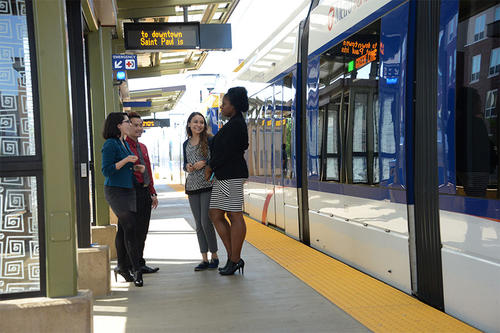
Women often have different transportation needs, and face different transportation challenges, than men. Women frequently have personal security concerns in dark or deserted transit areas, need to make multiple short stops as part of their commutes, and travel during off-peak hours for part-time jobs such as those in the caregiving sector. These disparities are largely unaddressed in transportation plans and policies, and specifically in comprehensive city plans.
For her master’s thesis, recent Humphrey School of Public Affairs graduate Ania McDonnell studied gender disparities in transportation and crafted recommendations for cities—some that can be used now.
“We know gender is an important factor to consider in transportation planning and policy, but many planning processes do not explicitly address gender issues,” says McDonnell, who earned her Master of Public Policy degree in May. She is now a policy analyst with Flaherty and Hood in St. Paul.
For her analysis, McDonnell selected four cities in the Twin Cities metro area—Minneapolis, Bloomington, Little Canada, and Centerville—and assessed how their 2040 comprehensive plans address gender and transportation disparities. Local governments in the metro area are required to create these plans every 10 years.
Her analysis included a search of gender-disparity-related terms in the city plans, with words such as safety, mobility, accessibility, gender, woman, binary, childcare, and lighting. The terms were then matched with policies within the comprehensive plans to determine how the plans address (or do not address) gender disparities.
“My analysis found some strong policies—for example, Bloomington encourages transit providers to establish reverse commute service—while other policies were broad, vague, and in need of refinement,” she says.
Based on the findings, McDonnell has crafted six recommendations for cities:
- Collect city-level transportation data that is disaggregated by gender.
- Perform a gender and equity review of comprehensive plans before releasing them for public comment.
- Provide transportation vouchers—such as taxi vouchers or vanpool reimbursements—to women or individuals in caregiving roles who are receiving Temporary Assistance for Needy Families.
- Partner with transit agencies to allow “night stops” in which a person can ask the bus driver to pull over between stops; the driver would only open the front door to ensure no one follows the person off the bus.
- Connect school, daycare, and workplace land use through zoning and tax incentives.
- Prioritize tax incentives for employers to create transportation service between high-unemployment neighborhoods and areas of employment.
“These policies are just the tip of the iceberg,” says McDonnell. “Ultimately, I’d like to see cities add expertise in identifying and addressing gender and other demographic disparities—to help plan and deploy a more welcoming transportation system.”
-------
This story was adapted from the U of M’s Center for Transportation Studies.
- Categories:
- Law and Policy
- Transportation





